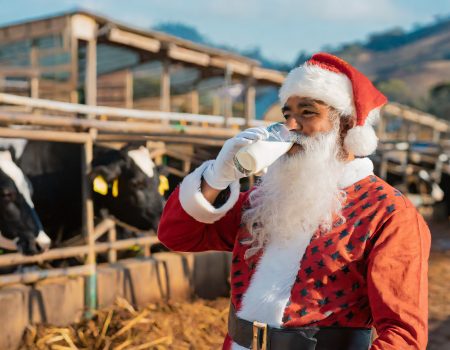Most Wisconsin workers who are injured on the job are covered by the state’s workers’ compensation system, which pays medical bills and a part of their income while they recover.
“One of the bedrock principles of worker’s compensation is universal coverage,” states the state’s Department of Workforce Development, which manages the workers’ compensation system, on its website. “That means that virtually every employee is covered.”
However, the legislation differs for farms, and many immigrant dairy workers — the backbone of one of the state’s most recognized yet deadly businesses — are not protected. Wisconsin exempts all types of farms with less than six employees who are not connected to the owners from having workers’ compensation coverage.
There seems to be no state or federal organization tracking how many of Wisconsin’s 5,700 or so dairy farms fit into that group – or how many workers lack coverage. The Wisconsin Farm Bureau Federation, one of the state’s most powerful lobbying organizations, doesn’t either.
However, the number of such farms is likely to be in the thousands, since many employ just one or two people. According to one national research, more than 23,000 agricultural workers in Wisconsin were exempt from workers’ compensation coverage in 2020, a higher number than in virtually every other state in the country.
The exemption from workers’ compensation comes on top of restrictions on the federal government’s enforcement of occupational health and safety regulations on these same small farms, essentially leaving businesses to police themselves.
Workers on small farms are not the only ones who are vulnerable. Many wounded agricultural laborers say they are too fearful of reprisal from their bosses to file claims. The situation is aggravated by immigration status: the majority of immigrants working on Wisconsin dairy farms are in the country illegally and are afraid of being dismissed or deported.
“Workers’ compensation doesn’t work for anyone, not even the workers who are supposed to benefit from it.” “It really doesn’t,” says Lola Loustaunau, an assistant professor at the University of Wisconsin-Madison’s School for Workers who is researching immigrant workers’ access to workers’ compensation in high-risk sectors. “That gets increasingly worse the more precarious workers are.”
This week, ProPublica reported on how undocumented dairy workers are routinely injured on the job and frequently go without medical treatment. When their injuries are serious enough that they can no longer work, they may be sacked and evicted from the accommodation provided by many businesses. Many people have little legal choices.
“The farm owner didn’t want to help me with anything,” said a 47-year-old man who was unable to work for many months this year after a cow pushed him into a wall, ripping the muscles and tendons in his shoulder from the bones. “They don’t really see us as full humans.”
According to state documents, the guy worked on a farm with two other laborers that lacked workers’ compensation insurance. He said he spent months without medical treatment until the proprietor of a Latino grocery shop in the region connected him with a local nonprofit group that assisted him in receiving hospital charity care.
Farms with as little as one person are required to obtain workers’ compensation insurance in more than a dozen states, including New York, California, and Idaho. Wisconsin’s exception for small farms is one of numerous federal and state exemptions that have traditionally given farm workers — particularly dairy workers — less rights and protections than others. Farm workers are not entitled to overtime pay or the opportunity to establish a union. Housing on dairy farms is typically uncontrolled and uninspected. As ProPublica has revealed, the federal Occupational Safety and Health Administration rarely never investigates worker fatalities and injuries on small farms.
According to a spokesman for the Department of Workforce Development, state law does not allow its Worker’s Compensation Division to offer services or programs to an injured worker whose employer is not obliged to have workers’ compensation insurance. “Division staff refer injured workers who contact the division with immediate needs to community-based organizations and other service providers,” a representative for the division stated.
In its annual policy book, the Wisconsin Farm Bureau states that it favors preserving the six-employee level for needing workers’ compensation insurance. Amy Eckelberg, a Farm Bureau spokesman, said in a statement that farmers from throughout the state decide the organization’s policy goals.
“Our farmers use every means available to avoid injuries to their employees, family members and themselves through appropriate education, training and physical precautions to mitigate against known safety threats,” she went on to say.
Over the last year, ProPublica interviewed more than 60 foreign laborers who claimed to have been harmed on Wisconsin farms. Workers on small and big farms have regularly claimed that their bosses overlooked their injuries.
Consider the instance of Luis, a Nicaraguan man who works on a farm in south-central Wisconsin that has workers’ compensation coverage, according to state records. He said that a cow kicked his hand one morning in January. “In that moment, I thought my hand was broken,” he told me. “I didn’t know what to do about the pain.” Luis said that he informed his manager, who responded, “It’s OK. “Keep working,” he said, and he did.
Later that day, he went to a Latino grocery shop to get pain relievers and bandages to help with the swelling. He was aware that his company had workers’ compensation insurance, but he didn’t want to bring it up. “It’s better not to say anything,” he told me. Luis never received medical attention.
Many workers who sought medical attention reported their bosses pressed them to persuade hospital authorities that their ailment was not work-related. According to one former hospital staffer, immigrant dairy workers who came into the emergency department would beg him not to record in their files that they were injured on the job. He said that they did not want the hospital to contact their company to inquire about workers’ compensation coverage because they were scared their bosses would get angry and dismiss them.
Some farms that are supposed to have workers’ compensation insurance do not have it. According to one worker who had his face battered in by a bull last year, at least seven other individuals worked on the farm. However, according to state documents, the farm lacked workers’ compensation coverage.
In interviews, more than a half-dozen workers said that workers’ compensation paid some or all of their medical expenditures and gave them with partial income while they recovered. Their bodies, however, have changed.
“My right hand is fucked,” claimed an Ecuadorian guy whose hand became entangled in a piece of equipment in a milking parlor, resulting in the loss of two fingers and the inability to use two others. “I’m unable to close my hand; it simply remains open.” When I attempt to use it often, it aches. And the agony is excruciating in the cold.”
“I’m unable to run. I can’t walk for more than 30 minutes. “My leg falls asleep,” said a Nicaraguan guy whose legs were crushed two years ago by a huge metal fence. “The farm owner told me I’m lucky to be alive because even cows can be killed there.”
“I kept trying to work, but I couldn’t stand the pain,” claimed a Nicaraguan man who hurt his spinal column after falling on concrete after slipping off a skid steer he was cleaning. “They laughed at me, saying I was making up the pain, that I didn’t want to work.”
Workers injured on small farms without workers’ compensation insurance have just one legal option to force their employers to pay their medical bills: sue them. However, few immigrant dairy workers do.
“A lot of people are afraid that suing will jeopardize their immigration status,” said Douglas Phebus, a lawyer who has represented dairy farm workers in personal injury claims. “The whole system is set up to burden these people. Everything is stacked against them.”
Unlike workers’ compensation claims, where a worker must simply establish that an accident occurred while on the job, the burden of evidence in personal injury cases is higher: workers must demonstrate that their employers were negligent.
And, with workers frequently working 70 to 80 hours per week, it might be difficult to locate an attorney — particularly one who knows Spanish — as well as the time to meet.
According to Kate McCoy, the occupational health and safety program director for the state Department of Health Services, immigrant dairy workers are particularly vulnerable to disability and death.
“From the public health standpoint, you never want to see a population that’s afraid to access medical care and is afraid to speak to health officials, and that’s one of the things we see with this population,” she said.
McCoy’s group is collaborating with Loustaunau and other University of Wisconsin academics to better understand the occupational health requirements of workers in high-risk occupations, such as immigrant dairy laborers, and the obstacles they experience when seeking workers’ compensation.
This month, the group convened its first listening session. Every worker who showed there, including numerous dairy workers, said that they had been sacked after being injured. Several people mentioned how they began to perceive being harmed and then being ridiculed or humiliated by a boss as part of the work, according to Loustaunau. Many discussed despair and the impact injuries had on their families.
“We know that there are fantastic farmers and farm employers who go out of their way to take care of employees,” he added. “But unfortunately the stories we heard last Friday night were [about] the folks that were not upholding what we would want.”
Officials from the health department intend to utilize what they learn from the listening sessions to offer workers with important information on workplace safety and the workers’ compensation system. They also want to provide workshops to teach workers how to navigate the claims procedure.
A worker at the hearing session claimed he was ridiculed, attacked, and threatened with deportation some years ago after falling more than ten feet while attempting to repair a barn curtain on a dairy farm. The guy had a concussion, memory loss, and spine injury, and he had to relearn how to walk and communicate. He and his wife traveled through the snow for almost an hour to attend the seminar. In an interview with ProPublica, the guy, an illegal immigrant from Mexico, said he wanted to share his story because he doesn’t want other dairy workers, particularly new immigrants, to go through what he did.
“We are not animals,” said the guy, who requested to be named only by one of his surnames, Paredes, out of fear of punishment from his previous employer. “As human beings, we have rights.”
Paredes’ medical expenditures were paid by workers’ compensation for many months, and he earned half salary during the time he was meant to be healing.
When the farm owner arrived to the home he provided for Paredes, his wife, and four children, he stated he still hadn’t been cleared by a doctor to return to work. The farm owner, according to Paredes and his wife, insisted that he return to work.
“Sometimes you don’t have another choice,” he told me. “A lot of us don’t want to speak up.”
But Paredes was no longer up to the task. Although his doctor ultimately approved him to work two hours each day, the farm owner pressed on longer shifts. According to Paredes, the farm owner mocked him, calling him a “cripple man” and “dumb,” and telling him to “go back to your pueblo because you’re not good for anything.”
“Once You’re No Good to Them, They Get Rid of You”
Paredes eventually felt compelled to resign. To compensate for the lost income, his wife took up three jobs, including milking cows at another farm and cleaning a church. Paredes said that he has not been able to work on a regular basis since the accident. He is saddled with thousands of dollars in medical bills for continuous treatment that is no longer covered by workers’ compensation. When he can, he does odd tasks like mowing grass or painting homes. However, he claims that when he conducts manual work, he has acute pain in his spine. And he said that his brain no longer functions as it once did. When he walks or drives, he experiences motion sickness and feels dizzy.
“I’m feeling useless,” he said. “Like I’m good for nothing.”






 Michael A. Snyder, age 76 of Baraboo, passed away on Tuesday, December 26, 2023 surrounded by his children at home. He was born on May 26, 1947 in Iowa City, Iowa to Allen and Bernice (Hardman) Snyder. He graduated from Williamsburg High School and earned his BS in Dairy Science from Iowa State University in 1972. On June 10, 1972, he married the love of his life, Barbara (Frotscher) Snyder in Farnhamville, Iowa.
Michael A. Snyder, age 76 of Baraboo, passed away on Tuesday, December 26, 2023 surrounded by his children at home. He was born on May 26, 1947 in Iowa City, Iowa to Allen and Bernice (Hardman) Snyder. He graduated from Williamsburg High School and earned his BS in Dairy Science from Iowa State University in 1972. On June 10, 1972, he married the love of his life, Barbara (Frotscher) Snyder in Farnhamville, Iowa.

 Santa Claus is well-known for accomplishing some miraculous tasks. In addition to delivering all those toys to millions of little boys and girls each night, he stops by each house to snack on milk and cookies left for him.
Santa Claus is well-known for accomplishing some miraculous tasks. In addition to delivering all those toys to millions of little boys and girls each night, he stops by each house to snack on milk and cookies left for him. Lynn F. Main, Sr. (Ken) Obituary 1945-2023
Lynn F. Main, Sr. (Ken) Obituary 1945-2023



